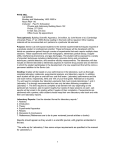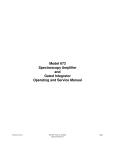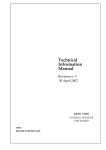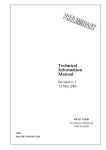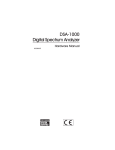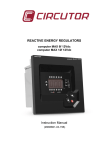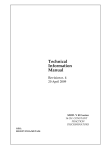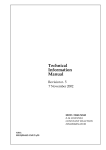Download Technical Information Manual
Transcript
Technical Information Manual Revision n. 4 14 June 2004 MOD. N968 SPECTROSCOPY AMPLIFIER MANUAL REV.4 NPO: 00100/03:N968x.MUTx/04 CAEN will repair or replace any product within the guarantee period if the Guarantor declares that the product is defective due to workmanship or materials and has not been caused by mishandling, negligence on behalf of the User, accident or any abnormal conditions or operations. CAEN declines all responsibility for damages or injuries caused by an improper use of the Modules due to negligence on behalf of the User. It is strongly recommended to read thoroughly the CAEN User's Manual before any kind of operation. CAEN reserves the right to change partially or entirely the contents of this Manual at any time and without giving any notice. Document type: User's Manual (MUT) Title: Mod. N968 Spectroscopy Amplifier Revision date: 14/06/2004 Revision: 4 TABLE OF CONTENTS 1. GENERAL DESCRIPTION ..........................................................................................................................................4 1.1 2. 3. OVERVIEW...............................................................................................................................................................4 TECHNICAL SPECIFICATIONS ...............................................................................................................................5 2.1 PACKAGING.............................................................................................................................................................5 2.2 POWER REQUIREMENTS.......................................................................................................................................5 2.3 FRONT AND BACK PANEL ....................................................................................................................................6 2.4 FRONT PANEL CONTROLS....................................................................................................................................7 2.5 INTERNAL JUMPERS..............................................................................................................................................8 2.6 FRONT PANEL DISPLAYS......................................................................................................................................9 2.7 INPUT /OUTPUT CONNECTIONS ..........................................................................................................................9 2.8 TECHNICAL SPECIFICATION TABLE .................................................................................................................10 FUNCTIONAL DESCRIPTION................................................................................................................................ 12 3.1 SHAPING DETERMINATION ...............................................................................................................................12 3.2 EQUIPMENT FACILITIES.....................................................................................................................................12 3.3 CIRCUIT DESCRIPTION........................................................................................................................................13 LIST OF FIGURES FIG. 2.1: M OD. N968 FRONT AND BACK PANEL .............................................................................................................6 FIG. 2.2: M OD. N968 SIDE VIEW WITH JUMPERS LOCATION ........................................................................................8 FIG. 2.3: UNIPOLAR OUTPUT EQUIVALENT RMS NOISE VS. SHAPING TIME (TS).................................................11 FIG. 2.4: BIPOLAR OUTPUT EQUIVALENT RMS NOISE VS. SHAPING TIME (TS)....................................................11 FIG. 3.1: N968 CIRCUIT BLOCK DIAGRAM ......................................................................................................................13 FIG. 3.2: N968 I/O TIMING DIAGRAM ..............................................................................................................................14 LIST OF TABLES TABLE 2.1: POWER REQUIREMENTS................................................................................................................................5 TABLE 2.2: M OD. N968 TECHNICAL FEATURES...........................................................................................................10 NPO: 00100/03:N968x.MUTx/04 Filename: N968_REV4.DOC Number of pages: 14 Page: 3 Document type: User's Manual (MUT) Title: Mod. N968 Spectroscopy Amplifier Revision date: 14/06/2004 Revision: 4 1. General description 1.1 Overview The Mod. N968 is a spectroscopy amplifier implemented in a single-width NIM module. It accepts the typical outputs generated from either optical feedback or resistor feedback preamplifiers connected with nuclear particle detectors. A front panel switch allows to select between positive and negative input signals. Gain setting can be performed continuously in the 10 ÷ 1500 range, product of Coarse, Fine and Superfine Gain. Two internal jumpers allow to set a x0.1 attenuation and a further x2 amplification, thus extending the gain range to 1 ÷ 3000. Shaping time (Ts) values are 0.5, 1, 2, 3, 6, 10 µs. The Pole Zero (PZ) cancellation is performed via a front panel screw-trimmer. The module features also: - a Bipolar output (to be used for timing purposes) An advanced Baseline Restorer (BLR) circuit, with either manual or automatic threshold setting A Pile Up Rejector (PUR) which allows to reject piled up events NPO: 00100/03:N968x.MUTx/04 Filename: N968_REV4.DOC Number of pages: 14 Page: 4 Document type: User's Manual (MUT) Title: Mod. N968 Spectroscopy Amplifier Revision date: 14/06/2004 Revision: 4 2. Technical specifications 2.1 Packaging The Model N968 is housed in a single width NIM module. 2.2 Power requirements Table 2.1: Power requirements +12 V -12 V +24 V -24 V NPO: 00100/03:N968x.MUTx/04 Filename: N968_REV4.DOC 200mA 200 mA 200 mA Number of pages: 14 Page: 5 Document type: User's Manual (MUT) 2.3 Title: Mod. N968 Spectroscopy Amplifier Revision date: 14/06/2004 Revision: 4 Front and back panel Mod. N968 SPECTROSCOPY AMPLIFIER SFG UNI BI INPUT CRM FINE GAIN 0.5 - 1.5 100 200 50 500 20 1K COARSE GAIN 2µs BUSY INH RTP LTC 3µs 1µs 6µs 0.5µs 10µs SHAPING TIME UNCOMP PREAMP OUT OVCOMP AUTO B L R PZ ADJ THR -12V 9 NC 8 +24V 7 -24V 6 5 PRS 4 +12V 3 NC 2 CL_GND 1 A_GND INPUT DELAY POS ON OFF NEG DC UNI BI Fig. 2.1: Mod. N968 Front and back panel NPO: 00100/03:N968x.MUTx/04 Filename: N968_REV4.DOC Number of pages: 14 Page: 6 Document type: User's Manual (MUT) 2.4 Title: Mod. N968 Spectroscopy Amplifier Revision date: 14/06/2004 Revision: 4 Front panel controls FINE GAIN: 10-turn precision potentiometer with graduated dial for continuously variable direct-reading gain factor of x0.5 to x1.5. COARSE GAIN: 6-position switch, selects feedback resistors for gain factors of 20, 50, 100, 200, 500, and 1k. Two Jumpers on the printed circuit board select x0.1 attenuation and x2 Amplification (see § 2.5). S.F. GAIN: SUPERFINE GAIN, screwdriver adjustable potentiometer to adjust fine gain; adjustment range: ±2.5 % of the FINE GAIN RANGE. INPUT: Locking toggle switch, selects either Pos (positive) or Neg (negative) input pulse polarity. SHAPING TIME: 6-position switch, selects time constants for active pulse-shaping filter network from 0.5, 1, 2, 3, 6, and 10 µs. PZ ADJ1: Screwdriver adjustable potentiometer to set the pole-zero cancellation to compensate input decay times from 40 µs to infinity. DELAY: Locking toggle switch, allows to set UNIpolar output either to prompt or delayed 2 µs. BLR: 3-position locking toggle switch, selects the source of control for the gated baseline restorer discriminator threshold from: − Auto The BLR threshold is automatically set to an optimum level, as a function of the signal noise, by an internal circuit. − PZ Adj Enables the PZ adjustment; the BLR threshold is determined by the Auto function. The BLR time constant is also greatly increased to facilitate the PZ adjustment. − Threshold The BLR threshold is manually set by the threshold potentiometer in the 0 ÷ 300 mV range. DC: Screwdriver adjustable potentiometer to set the Unipolar Output DC level; range ±100 mV. 1 The adjustment must be performed with a low rate input NPO: 00100/03:N968x.MUTx/04 Filename: N968_REV4.DOC Number of pages: 14 Page: 7 Document type: User's Manual (MUT) 2.5 Title: Mod. N968 Spectroscopy Amplifier Revision date: 14/06/2004 Revision: 4 Internal Jumpers Some settings can be performed via internal jumpers (location is shown in Fig. 2.2). Preamp Gain (sw4): allows to set the input preamplifier stage gain either at x1 or x0.1 PRS Polarity (sw3): allows to configure the module in order to accept on the PRS input either positive or negative pulses. If the preamplifier connected to the N968 does not feature the PRS, set the jumper to positive G.A. Gain (sw1): allows to introduce either a x2 or x1 gain factor at the Gated Amplifier stage Th. Symmetry (sw5): allows to set the BLR negative threshold either symmetric (equal to the BLR threshold) or asymmetric (BLT threshold + 300mV) x2 sw1 x1 PRS POLARITY NEG POS sw3 x1 x0.1 sw4 ASYMM SYMM sw5 Fig. 2.2: Mod. N968 side view with jumpers location NPO: 00100/03:N968x.MUTx/04 Filename: N968_REV4.DOC Number of pages: 14 Page: 8 Document type: User's Manual (MUT) 2.6 Title: Mod. N968 Spectroscopy Amplifier Revision date: 14/06/2004 Revision: 4 Front panel displays PZ VISUAL INDICATOR: PZ Visual Indicator leading to high precision adjustment of the pole-zero cancellation, for exact compensation of the decay time of the preamplifier signal. Left LED signals overcompensation, right LED under compensation. Setting the BLR switch to the adjust position activates the PZ Visual Indicator. Under compensation can be corrected by turning the potentiometer clockwise, while over compensation requires the potentiometer to be turned anti-clockwise. A correct Pole Zero setting is signalled by the two LEDs off (or, at least, blinking low). 2.7 Input/Output connections INPUTS: INPUT BNC front- and rear-panel connectors, accept either positive or negative pulses with rise times of 10 to 500 ns and decay times of 40 µs to infinity; if Preamp Gain = 1, Zin ≅ 1000 Ω DC-coupled / ≅ 500 Ω AC-coupled; if Preamp Gain = 0.1, Zin ≅ 1000 Ω DC-coupled / AC-coupled linear maximum: 1V (Preamp gain = 1, Amplifier gain = 10), 10 V (x01 attenuation selected); absolute maximum: 10 V. Front-panel INPUT is provided with a test point. RTP (Rise Time Protection) Rear-panel BNC connector (TTL signal, 50 Ω impedance), it is provided by the Multichannel Analyzer (MCA) to communicate to the amplifier that the ADC lower level threshold is exceeded and the signal has been accepted. It is used only in the Live Time Corrector (LTC) circuit. PRS Reset signal on the Rear-panel D-type 9 pin female connector. OUTPUTS: UNI Front-panel BNC connector with Z < 0.5 Ω and rear-panel connector with Z = 93 Ω; short-circuit maximum duration: 10 s (Frontpanel), ? 8 (Rear-panel); full-scale linear range of 0 to +10 V; active filter shaped; DC-restored; DC-level adjustable to ±100 mV. Front-panel UNI output is provided with a test point. BI Front-panel BNC connector with Z <1 Ω and rear-panel connector with Z = 93 Ω; short-circuit maximum duration: 10 s (Front-panel), ? 8 (Rear-panel); prompt output with positive lobe leading and linear range of ±10 V; active filter shaped. Front-panel BI output is provided with a test point. CRM Rear-panel BNC connector with Z <10 Ω provides a nominally +5 V, 100 ns logic pulse every time the input signal exceeds the baseline restorer fast discriminator threshold. INH Rear-panel BNC connector with Z <10 Ω provides a nominally +5 V logic pulse (suitable for the MCA anticoincidence input) when the internal pile-up rejection logic detects a distortion of the input signal due NPO: 00100/03:N968x.MUTx/04 Filename: N968_REV4.DOC Number of pages: 14 Page: 9 Document type: User's Manual (MUT) Title: Mod. N968 Spectroscopy Amplifier Revision date: 14/06/2004 Revision: 4 to pile-up. Signals whose peak occurs when the INH signal is active must be thus rejected. BUSY Rear-panel BNC connector with Z <10 Ω provides a +5 V logic pulse for the duration that the input pulse exceeds the baseline restorer discriminator. LTC Rear-panel BNC connector, provides a positive true TTL logic signal that is used to stop the MCA time counter; this allows a precise evaluation of the source actual rate. PREAMP POWER Rear-panel D-type 9 pin female power connector; it mates with captive and noncaptive power cords on almost all preamplifiers. Contact assignment is shown in Fig. 2.1. 2.8 Technical specification table Table 2.2: Mod. N968 Technical Features Packaging One unit wide NIM unit Gain range 1 ÷ 3000 UNIpolar shape: quasi Gaussian, peaking time 2.4 Ts, pulse width at 0.1% level equal to 2.9 times the peaking time Bipolar shape: approximate derivative, time to crossover 3 Ts Pulse shape Integral non linearity Temperature instability (0 to 50°C) <± 0.025% @ 2 µs shaping time Gain: < ±50 ppm/°C. DC level: UNIpolar output: < ±10 µV/°C BIpolar output: < ±30 µV/°C ≤ ±3 ns at 2 µs Ts for 50:1 dynamic range Bipolar crossover walk Overload recovery Recovers to within 2% of rated output from X300 overload in 2.5 nonoverloaded pulse widths using a gain of 1000 for UNIpolar Output. Same recovery from X1000 overload for BIpolar Spectrum broadening Typical: <16% FWHM for a 60Co 1.33 MeV gamma line at 85% of full scale for an incoming count rate of 103 to 105 counts/s (Unipolar Output, 2-µs shaping) Spectrum shift Peak position typical shift: <0.024% for a 60Co 1.33 MeV gamma line at 85% of full scale measured from 10 3 to 105 counts/s (Unipolar Output, 2-µs shaping) (T.B.C.) Equivalent noise 4 µV / 6 µV (RMS) for UNIpolar/Bipolar output for 3 µs shaping time and coarse gain = 100 3.5 µV / 5 µV (RMS) for UNIpolar/Bipolar output for 3 µs shaping time and coarse gain = 1000 [Fig. 2.3: Equivalent RMS Noise Vs. Shaping Time (Ts)] NPO: 00100/03:N968x.MUTx/04 Filename: N968_REV4.DOC Number of pages: 14 Page: 10 Document type: User's Manual (MUT) Title: Mod. N968 Spectroscopy Amplifier Revision date: 14/06/2004 Revision: 4 Equivalent RMS Noise (µV) UNIPOLAR OUT 9 8 7 6 5 4 3 2 1 0 Gain=1000 Gain=100 0 2 4 6 8 10 Ts (µs) Fig. 2.3: UNIpolar Output Equivalent RMS Noise Vs. Shaping Time (Ts) Equivalent RMS Noise (µV) BIPOLAR OUT 10 9 8 7 6 5 4 3 2 1 0 Gain=1000 Gain=100 0 2 4 6 8 10 Ts (µS) Fig. 2.4: BIpolar Output Equivalent RMS Noise Vs. Shaping Time (Ts) NPO: 00100/03:N968x.MUTx/04 Filename: N968_REV4.DOC Number of pages: 14 Page: 11 Document type: User's Manual (MUT) Title: Mod. N968 Spectroscopy Amplifier Revision date: 14/06/2004 Revision: 4 3. Functional description 3.1 Shaping determination The proper shaping time constant must be seen as the better compromise in order to match high count rates requirements (which lead to small time constant) and good signalto-noise ratios (which lead to big values). For scintillation counters the energy resolution depends largely on the detector (scintillator and photomultiplier), therefore a shaping time constant of about four times the decay time constant of the scintillator is a reasonable value. Gas proportional counters usually have a collection time in the 0.5 ÷ 5 µs range, so a ~2 µs time constant could provide a good resolution. Instead, for surface barrier semiconductors, a time constant in the 0.5 ÷ 2 µs range is recommended. 3.2 Equipment facilities In order to provide the User with an equipment suitable for almost any spectroscopy application, the Mod. N968 includes: − a Pile-up Rejector/Live Time Corrector (PUR/LTC) circuitry which allows operation with minimal dependence on system count rate. The PUR circuit interrogates incoming pulses for pile up and generates a signal that prevents the ADC from converting the piled up events. The LTC circuit then generates a system dead time that extends the collection time to compensate for the events lost due to pileup rejection. The result is lower background, better resolution and accurate live time information for the best possible analysis results. − a gated Baseline Restorer (BLR), which includes a discriminator that operates the sensing circuits that normally establish the baseline reference of the Multichannel Analyzer (MCA). Performance of the spectrometer depends on the precision of the setting of the BLR threshold. Such automatic threshold control typically gives as good or better results than those the most experienced operator could achieve manually. − a Pole Zero (PZ) Visual Indicator: a LED adviser which leads to high precision adjustment of the pole-zero cancellation, for exact compensation of the decay time of the preamplifier signal. Two LEDs indicate either over-compensation or undercompensation. − a Bipolar Output, which provides a zero-crossing pulse, suitable for precisely detecting the radiation arrival time. In fact, the zero-crossing of the pulse occurs with a constant delay with respect to the onset of the pulse, independently from the amplitude, thus allowing to reduce time-walk effects. − an Inhibit Output, which provides a pulse when pile-up occurs. This pulse shall be applied to the MCA’s anticoincidence input in order to prevent it from measuring and storing a non-valid amplitude. NPO: 00100/03:N968x.MUTx/04 Filename: N968_REV4.DOC Number of pages: 14 Page: 12 Document type: User's Manual (MUT) 3.3 Title: Mod. N968 Spectroscopy Amplifier Revision date: 14/06/2004 Revision: 4 − a Busy Output, which provides a pulse whose width is equal to the time the input pulse exceeds the BLR discriminator level and is automatically extended by the generation of an Inhibit signal. − a CRM (Count Rate Meter) Output, which generates a TTL signal every time a valid input pulse arrives. Circuit description The input signal provided by the preamplifier is processed in the way described in the Fig. 3.1 block diagram: BIPOLAR FILTER & OUTPUT STAGE POLARITY INPUT GAIN STAGES INPUT STAGE BIPOLAR OUTPUT SHAPING STAGE UNIPOLAR OUTPUT STAGE & DELAY INPUT ATTENUATOR UNIPOLAR OUTPUT BASE LINE RESTORER POLE ZERO VISUAL INDICATOR SLOW DISC BASELINE BUSY GATED LOGIC POLE ZERO ADJUSTMENT COUNT RATE METER LIVE TIME CORRECTION MANUAL THRESHOLD RISE TIME PROTECTION AUTO THRESHOLD FAST DIFFERENTIATOR FAST DISC PILE UP DETECTION LOGIC INHIBIT Fig. 3.1: N968 circuit block diagram The amplifying chain is composed by a preamplifier (input stage) and the gain stages. The coarse, fine and super-fine gain controls operate over these stages, allowing to set the gain level. The polarity setting is performed through a stage which is configured either inverting or non-inverting. The subsequent shaping stage consists of a double 4-pole integrator which forms the pulse semi-gaussian profile. The chain composed by both the amplifying and the shaping stages is configured as “gated-amplifier”, in order to compensate the amplifiers’ thermical drift and offsets, which would lead to high gain levels saturation and output dynamics reduction. The fast differentiator stage allows to acquire the pulse’s arrival time through a comparator (fast discriminator), whose output is used also to form the Count Rate Meter (CRM) output. Another comparator (slow discriminator) provides the BUSY output, operating directly over the UNIpolar output. The baseline restorer (BLR) also operates over the UNIpolar output, and its purpose is to keep the baseline constantly at the level set through the DC control, in order to decouple the pulse acquisition from the input rate. NPO: 00100/03:N968x.MUTx/04 Filename: N968_REV4.DOC Number of pages: 14 Page: 13 Document type: User's Manual (MUT) Title: Mod. N968 Spectroscopy Amplifier Revision date: 14/06/2004 Revision: 4 The chain is completed by the UNIpolar output stage, the delay circuit and the BIpolar forming and output stage. The fast and slow discriminators thresholds can be set either manually or automatically; in the latter case, a circuit provides the threshold value according to the UNIpolar output noise level. The gated-logic block manages the signals provided by the discriminators, the baseline restorer and performs the pile-up rejection (PUR) and live-time correction (LTC). The timing diagram in Fig. 3.2 shows the PUR function and the circuit response to a pulse pile-up: the second pulse arrives before the circuit recovers from Busy, the Fast Differentiator produces another signal that triggers the discriminator to update the Busy output and to provide another CRM pulse. In the meantime, at the arrival of the second pulse, a bistable, set by the first pulse, produces the Inhibit output. The LTC function is also shown in Fig. 3.2: after a piled-up event detected and then rejected by the MCA (with the subsequent production of the RTP signal, which communicates that the output has exceeded the MCA internal threshold), the LTC signal is produced and kept active until the next RTP. While the LTC signal is active, the MCA halts its internal time counter, thus allowing to obtain a correct input rate value (the greater the number of pulses, the better the rate value measure): in fact the live time measured by the MCA will be obtained by subtracting the MCA dead time and the time the LTC is active from the total time. In this way the source actual rate will be equal to the ratio between the number of converted pulses and the live-time. 3rd event 2nd event 1st event N968 INPUT SHAPERS INPUT distortion due to pileup UNIPOLAR OUTPUT FAST DIFF. OUTPUT CRM OUTPUT BUSY OUTPUT INHIBIT OUTPUT LTC OUTPUT MCA RTP OUTPUT Fig. 3.2: N968 I/O timing diagram NPO: 00100/03:N968x.MUTx/04 Filename: N968_REV4.DOC Number of pages: 14 Page: 14














